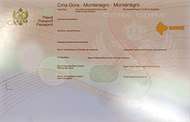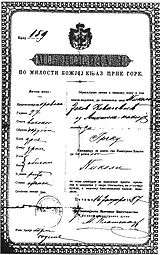Montenegrin passport
The Montenegrin passport (Montenegrin: pasoš / пасош) is the primary document of international travel issued by Montenegro.
| Montenegrin passport | |
|---|---|
 Contemporary biometric Montenegrin passport front cover | |
 Identity page of the Montenegrin passport | |
| Type | Passport |
| Issued by | |
| First issued | 5 May 2008 (current version)[1] |
| Purpose | Identification |
| Eligibility | Montenegrin citizenship |
| Cost | €33[2] |
The passport is issued by the Ministry of Interior or, if the citizen resides abroad, at the embassy. Besides serving as proof of identity and of citizenship, they facilitate the process of securing assistance from Montenegrin consular officials abroad, if needed. Citizens can not have multiple passports at the same time, unless they are of different category.
History
The first passports issued in Montenegro are from the 18th century, by Prince-Bishop Vasilije III Petrović-Njegoš.
After Vasilije ethnicity was never a part of Montenegrin passports again. During the reign of Prince-Bishop Petar I Petrović-Njegoš, a special document known as "Passport" (Serbian: Пашепорт) was granted to the citizens who wanted extraordinarily to visit foreign countries.
During the reign of Prince-Bishop Petar II Petrović-Njegoš, he was granting a special Montenegrin Bill of Passage. From then on, next to every user of the bill and subsequent passports, "Montenegrin" was added, relating to the country of his or her birth. It also introduced the notification from which clan is the individual. Later, Njegos formally instituted as the official name "Montenegrin Passport".[3] A component part of it was the Seal of the Cetinje Metropolitanate's Righteous Soviet, a bicephalic white eagle with spread-out wings, an Eastern Orthodox cross between his heads and a passing lion beneath it, altogether on red background.
With the secularization of Montenegro as a formal Princedom under Prince Danilo I Petrovic-Njegos, religious affiliation and even physical description of the passport holder were introduced as of the mid 19th century, in attempt to prevent fraud.[4] The Seal was replaced with Danil's Coat of Arms, the lion was moved onto a red shield on the eagle's chest, while an Imperial crown was added.


The passports issued by Nikola I Petrovic-Njegos were significantly changed in appearance, also losing any reference to nationality.[5] The same were the unrecognized passports published by the Montenegrin Government in Exile in 1919, after the country's annexation by Serbia.
Following the breakup of Yugoslavia, passports were issued in order with the "Law on Travel Documents of Yugoslav Nationals" which came into force on 26 July 1996, although the country came into existence in 1992. They were navy blue in color and have two inscriptions in golden letters - Савезна Република Југославија (Federal Republic of Yugoslavia) at the top and the word passport written in three languages: Serbian (Cyrillic script), English and French at the bottom divided by the coat of arms. Following the restructuring of the FRY into the State Union of Serbia and Montenegro in 2003, passports with the new name were not issued due to the expected breakup of the union, which eventually happened in 2006.
Following Montenegro's independence, citizens of Montenegro used the same travel document as Serbia until 2008, the only difference being in issuing authority, in this case, the Ministry of Interior of Montenegro.
On 30 November 2006, the Government adopted the Memorandum of Agreement between the Republic of Montenegro and the Republic of Serbia on Consular Protection and Services to the Citizens of Montenegro. By this agreement, Serbia, through its network of diplomatic and consular missions, provides consular services to the Montenegrin citizens on the territory of states in which Montenegro has no missions of its own.
On 1 January 2010, the Government officially invalidated all non-biometric Montenegrin passports, even if the expiry date was beyond 1 January 2010. Because non-biometric Montenegrin passports were no longer considered valid travel documents from that date onwards, holders were obliged to apply for new biometric Montenegrin passports in order to travel.[6]
Appearance
Design
The current passports are burgundy-red with the Montenegrin coat of arms. The data page is printed in Montenegrin, English and French. Unlike the passports issued through history of Montenegro, which used both the Cyrillic and Latin alphabets, the current Montenegrin passport uses the Latin alphabet exclusively.
Identity information page
The passport includes the following data:
- Country code ('MNE' for Montenegro)
- Nationality ('MNE' for Montenegrin )
- Type ('P' for passport)
- Passport serial number
- Name of bearer
- Place of birth
- Date of birth (DD.MM.YYYY.)
- Sex
- National identity number (JMBG)
- Date of issue (DD.MM.YYYY.)
- Date of expiry (DD.MM.YYYY.)
- Issuing office (Ministry of Interior of Montenegro)
- Signature and photo of bearer
The information page ends with the Machine Readable Zone and the identity page also contains the RFID chip.
Languages
The data page is printed in Montenegrin, English and French, while the personal data is entered in Montenegrin.
Types
Passports that can be issued are:
- Ordinary passport is issued to all citizens.
- Valid for 10 years
- Collective passport is issued to groups traveling together.
- Valid for a single trip abroad.
- Though it is not primary means of international travel for organised groups, it is often used to facilitate the issuance of visas or to decrease administrative costs if a lot of group members do not have their individual passports. Main users of these passports are high schools and tourist agencies.
- Collective passport can be used for travel only to specific, usually nearby, countries. Some countries that do not accept collective passport as valid travel ID, do issue collective visas, but still stamp individual passports.
- All members of the group must cross the border at the same time and be part of the same organized trip.
- Diplomatic passport is issued by the Ministry of Foreign Affairs to diplomats, high-ranking officials, members of the Parliament and persons traveling on official state business, and in some cases to immediate family members of the above.
- Validity is determined by the nature of the position held - diplomats and officials will usually receive the passport covering their mandate in office.
- Official passport is identical in all aspects to the diplomatic passport, but lacks the privileges of diplomatic immunity. It is issued to mid and low-ranking officials, as well as to non-diplomatic staff at the embassies and consulates.
Montenegrin investment-based citizenship
On 3 October, 2019, the government of Montenegro announced that it was receiving applications for its citizenship-for-investment programme that will last until 2022.
Those who want to obtain Montenegro citizenship through the programme must buy real estate approved by the state or donate to a specified public fund.
- A passport of Montenegro takes 3-6 months to be issued.
- Besides the investor, citizenship is granted to the investor's spouse. While their children (under 18 and financially dependent on the investor) will be given a residency permit until they turn 18, when they will be eligible to become citizens.
- Citizenship is inheritable.
- It is not necessary to live in Montenegro or speak the local language.
- Investments can only be made in state-approved projects.
- It is possible to sell the property/properties after five years.
- The entire refundable investment amount sits in a secure escrow account.
- The programme will last for three years and has a quota of 2,000 applications. [7]
See also
- Visa requirements for Montenegrin citizens
- Visa policy of Montenegro
- Montenegrin identity card
- Montenegrin nationality law
- List of passports
References
- Postupak i potrebni dokazi za izdavanje ličnih dokumenata -PASOS
- http://www.njegos.org/passports/pasos1.jpg
- http://www.njegos.org/passports/pasos3.jpg
- http://www.njegos.org/passports/pasos4.jpg
- INVALIDATED PASSPORTS, EFFECTIVE 1 JANUARY 2010
- "Getting Montenegrin investment-based citizenship in 2020". Tranio. 25 June 2020.
External links
- Ministry of Foreign Affairs and European Integration
- Njegoskij|org :: European Commission launches dialogue with Montenegro on visa-regime liberalisation (with photos of the new Montenegrin identity papers: passport, ID card, driving licence)
- Njegoskij|org :: 33 top university students rewarded by receiving the first new Montenegrin passports